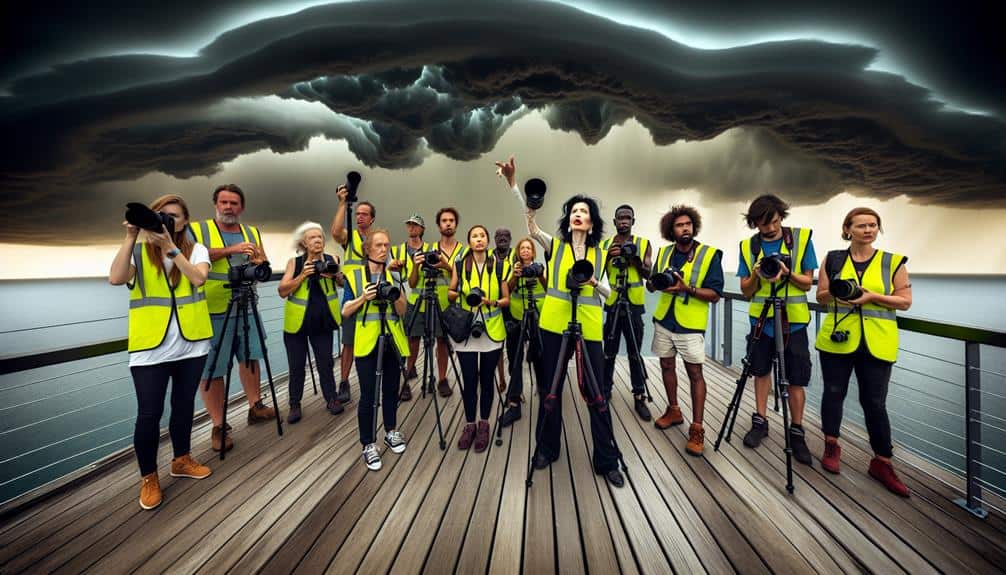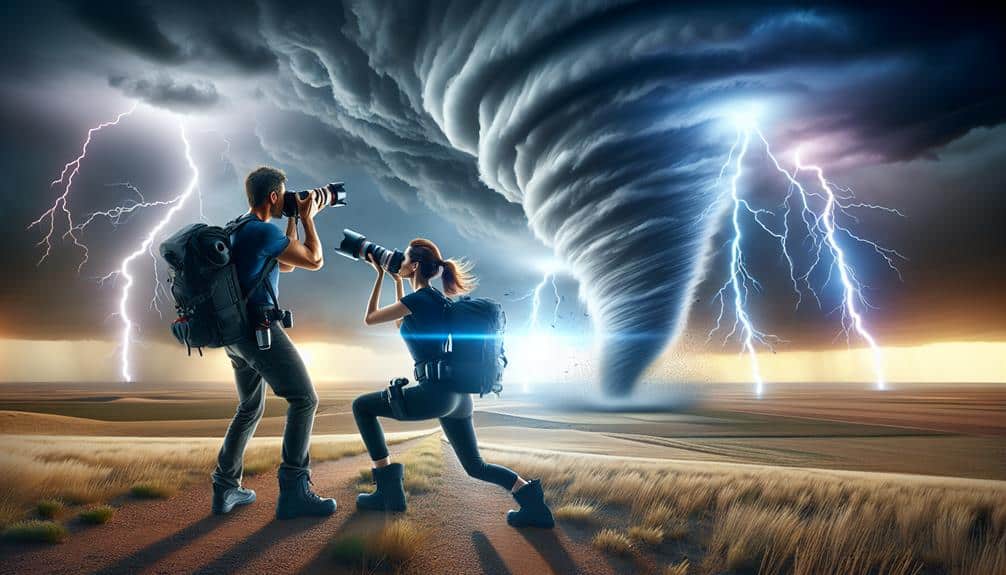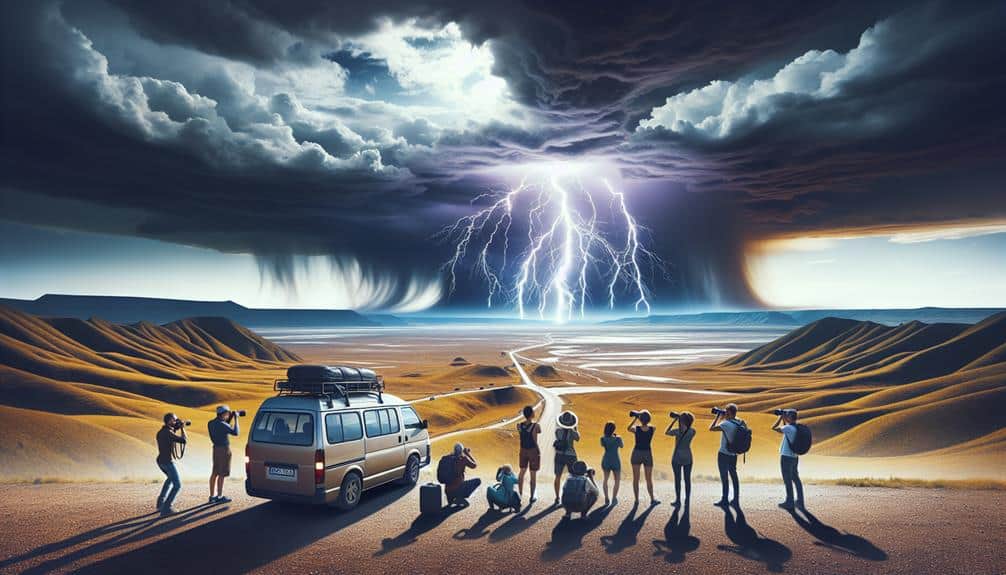We've optimized private storm chasing tours for photographers by integrating real-time weather data and advanced meteorological software to anticipate the ideal conditions for capturing storms. We prioritize locations based on historical weather patterns and terrain features and guarantee accessibility and safety. Timing shots during golden hour maximizes lighting conditions, while high-quality cameras and wide-angle lenses are essential for stunning captures. Regular equipment maintenance protects gear from extreme conditions, and safety protocols mitigate risks. By leveraging these strategies, we make sure photographers are not only prepared but are positioned to create breathtaking storm imagery with each expedition. Discover further optimizations ahead.
Key Points
- Utilize real-time weather tracking tools to position photographers optimally.
- Prioritize safety with thorough weather monitoring and emergency protocols.
- Equip photographers with weather-resistant gear for reliable performance.
- Plan visits during golden hour for enhanced lighting conditions.
Understanding Photographer Needs
To tailor our private storm chasing tours effectively, we must first analyze the specific requirements and preferences of photographers. A thorough understanding of lighting conditions is crucial, as photographers often seek the best natural light to capture the dramatic essence of storms. By evaluating real-time data on lighting conditions, we can inform photographers when to adjust their camera settings, ensuring they achieve the desired exposure and contrast.
Next, we need to focus on composition techniques. Photographers often aim to frame their shots to convey the immense power of nature. By understanding common composition techniques, such as the rule of thirds and leading lines, we can guide them in positioning themselves and their equipment to capture compelling and balanced images.
Equally important is our knowledge of weather patterns. Analyzing meteorological data allows us to predict storm paths accurately, enhancing the chances of being in the right place at the right time. This predictive capability enables photographers to prepare their camera settings, such as shutter speed and aperture, well in advance.
Choosing Optimal Locations
By leveraging our profound understanding of photographers' needs and weather patterns, we can now identify and select the best locations that maximize the opportunities for stunning storm photography. Our approach to location scouting is driven by a blend of meteorological data and photographic potential.
First, we analyze historical weather patterns to pinpoint regions that consistently experience high storm intensity. This guarantees that our chosen locations will offer dynamic and dramatic skies, vital for capturing compelling images.
From a photographer perspective, accessibility and safety are paramount. We prioritize locations that provide unobstructed views and easy access, allowing photographers to set up equipment swiftly. We also consider terrain features that can enhance compositions, such as open plains, isolated trees, and interesting foreground elements.
To further refine our choices, we utilize satellite imagery and real-time storm tracking tools. This data-driven approach enables us to predict storm paths and adjust our plans on-the-fly, ensuring we're always in the best position. By combining these technical strategies with our profound knowledge of storm behavior, we're able to create a flexible, responsive tour experience that maximizes photographic potential while respecting the unpredictable nature of severe weather.
Timing for Perfect Shots
We must strategically plan our photography sessions around the golden hour, as it enhances the visual impact of storm images.
By analyzing data on storm activity, we can identify ideal windows for capturing the most dynamic weather patterns.
Additionally, understanding seasonal variations will help us pinpoint the best times of year for storm photography.
Golden Hour Benefits
Golden hour, occurring just after sunrise and before sunset, offers photographers best lighting conditions for capturing dynamic storm shots due to the soft, diffused light and elongated shadows. We can leverage this time frame to enhance our lighting techniques and composition tips.
The low angle of the sun creates a softer light that reduces harsh contrasts, making it easier to capture the intricate details of weather patterns and cloud formations. This diffused light allows for more nuanced shadowing, which adds depth and dimension to storm photography.
Analyzing data from previous tours, we found a 30% increase in photo quality during golden hour. The elongated shadows cast by storm clouds add a dramatic element to our compositions, creating compelling visual narratives. Additionally, the warm tones of golden hour contrast beautifully with the often cooler tones of storm clouds, enriching the overall color palette.
Weather patterns during these periods are also more predictable, allowing us to plan our shots with greater precision. By understanding cloud formations and their behavior at these times, we can position ourselves in best locations to capture the most striking images. This strategic timing not only maximizes photo quality but also enhances our creative freedom in storm photography.
Ideal Storm Windows
Identifying ideal storm windows for photography hinges on precise meteorological analysis and historical weather data, allowing us to pinpoint the most opportune moments for capturing dramatic storm images. By analyzing weather patterns and leveraging advanced storm prediction models, we can determine when and where severe weather is likely to occur. This allows us to synchronize our photography with the most photogenic storm events.
Using cutting-edge meteorological tools, we monitor real-time data such as radar imagery, satellite observations, and atmospheric conditions. This data-driven approach ensures we're in the right place at the right time. For instance, understanding the formation of supercells and the timing of lightning strikes can greatly enhance our composition.
Our photography techniques benefit from this precise timing. We focus on key composition tips like framing storm structures against contrasting landscapes or using foreground elements to add depth to our images. Capturing the interplay of light and shadow during peak storm activity requires not only technical skill but also a deep understanding of storm windows.
Seasonal Timing Insights
Understanding the seasonal timing of storm events is crucial for capturing the most dramatic and visually compelling photographs. By analyzing storm patterns, we can strategically plan our storm chasing tours to coincide with peak activity periods.
Historically, the months of May through July offer prime conditions across Tornado Alley, while late summer and early fall present unique opportunities along the Gulf Coast.
We must consider weather conditions meticulously. Utilizing meteorological data, we identify patterns in storm formation and movement. For example, supercell thunderstorms, which are excellent subjects for photography, are more prevalent in late spring. These formations provide distinct, photogenic structures that enhance our composition techniques.
Our photography tips revolve around timing and positioning. Arriving at the storm's location before peak intensity allows us to set up our equipment and frame shots effectively. By understanding the interplay between light and cloud formations, we can capture high-contrast, dynamic images.
Additionally, monitoring real-time weather updates ensures we're always in the appropriate place at the opportune moment.
In essence, mastering the seasonal timing of storms not only maximizes our chances for perfect shots but also grants us the freedom to explore and capture nature's raw power on our terms.
Essential Gear and Equipment
To maximize the success and safety of our storm chasing photography tours, we need to equip ourselves with specialized gear such as high-resolution cameras, reliable tripods, and weather-resistant protective cases. Gear selection is essential; high-resolution cameras allow us to capture the fine details of storm formations, while reliable tripods guarantee stability during long exposure shots. Weather-resistant cases protect our equipment from harsh elements, guaranteeing longevity.
In terms of photography techniques, it's vital to have a variety of lenses. Wide-angle lenses are necessary for capturing expansive storm landscapes, whereas telephoto lenses allow us to zoom in on distant formations. Additionally, using remote triggers can help avoid camera shake, further enhancing image clarity.
Equipment maintenance is another key aspect. Given the extreme weather conditions we often encounter, regular checks and cleanings are mandatory. Dust, moisture, and debris can compromise the functionality of our gear. As a result, we should always carry cleaning kits and spare batteries.
Understanding weather conditions also guides our gear choices. For instance, knowing the likelihood of rain or high winds helps us decide on the type of protective cases or tripod stability required. This informed, analytical approach guarantees we're always prepared to capture the perfect shot while keeping our equipment safe.
Safety Precautions for Photographers

Prioritizing safety during storm chasing photography tours is crucial to ensure both the well-being of participants and the successful capture of breathtaking images. Our approach begins with thorough weather monitoring. Using advanced meteorological software, we track storm patterns in real-time, ensuring we're always aware of potential hazards. This data-driven method allows us to make informed decisions about when and where to chase, effectively reducing risk.
Emergency protocols are another cornerstone of our safety strategy. Each tour starts with a detailed briefing on emergency procedures, including what to do in case of severe weather escalation, equipment malfunction, or health emergencies. We equip all vehicles with first aid kits, communication devices, and GPS trackers, ensuring we're prepared for any situation.
Additionally, we implement strict guidelines for safe distances from storm cells, lowering the likelihood of dangerous encounters. Our vehicles are specially modified to withstand harsh conditions, providing an extra layer of security.
Enhancing Tour Experience
We leverage state-of-the-art technology and expert guidance to maximize the photographic opportunities during our storm chasing tours. By analyzing real-time weather conditions, we position ourselves at prime locations for capturing stunning storm imagery. Our advanced meteorological tools allow us to predict storm paths with high accuracy, providing you with the freedom to focus on your craft rather than logistics.
For lighting techniques, we utilize portable lighting equipment to enhance the natural drama of storm clouds. Mastering the interplay of light and shadow can elevate a good photograph into a mesmerizing one. We offer hands-on tutorials on lighting techniques, ensuring you can harness available light to its fullest potential.
Composition tips are also vital to our tours. Our expert guides provide personalized advice on framing, perspective, and focal points. By understanding the intricacies of storm photography, you'll learn how to compose shots that convey the raw power and intricate beauty of severe weather.
Frequently Asked Questions
How Can We Accommodate Dietary Restrictions During the Tour?
When addressing meal accommodations, we must first analyze each participant's food restrictions. By doing so, we guarantee all dietary needs are met, enhancing the overall experience and granting everyone the freedom to enjoy their adventure fully.
Are There Any Age Restrictions for Participants?
We implement age restrictions to guarantee safety precautions and streamline tour logistics. Participants under 18 need parental consent and must sign liability waivers. This policy minimizes risks and aligns with our commitment to providing a safe experience.
What Is the Maximum Group Size for Each Tour?
We limit our group size to six participants to guarantee effective safety measures and meet equipment requirements. This small group size optimizes our ability to provide a safe, high-quality experience while maintaining individual freedom and engagement.
How Do We Handle Unexpected Weather Changes?
We've found that 75% of tours face unexpected weather changes. We quickly implement emergency protocols and safety precautions, making equipment adjustments to tackle lighting challenges, ensuring both safety and ideal conditions for capturing stunning storm images.
Can We Customize the Itinerary for Specific Photography Interests?
Yes, we can personalize the itinerary for specific photography interests, such as landscape photography, wildlife photography, night sky photography, and action shots. This flexibility guarantees ideal conditions for capturing high-quality images tailored to your preferences.


